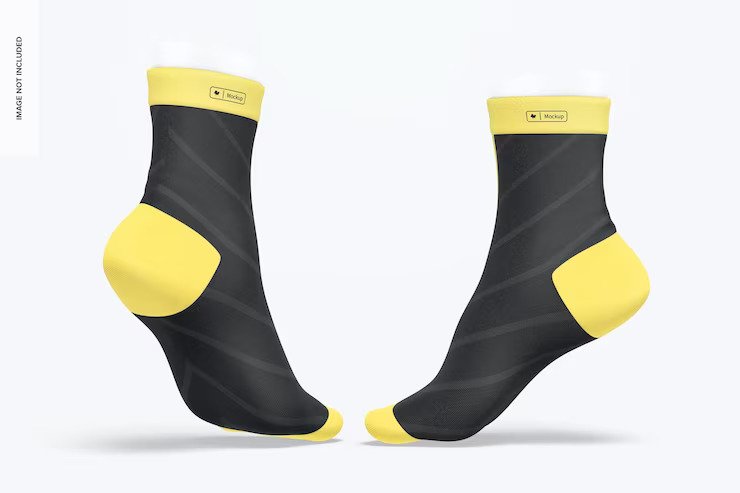
Socks With Grips For Dancers: Enhancing Your Moves
If you’re a dancer, you understand the importance of having the proper equipment to support your hobby. Every detail matters, from the right dance shoes to the appropriate outfit. For dancers, Grippy socks, socks with grips are a crucial but frequently disregarded component.
In this in-depth post, we’ll go deep into the realm of grippy socks and examine how they can significantly improve your dance moves.
Why Grippy Socks Matter
Before we get into the specifics of grippy socks, let’s talk about why they’re essential in the first place. Ballet, modern, and other dance styles require stability and traction to perform at their best.
On studio floors, ordinary socks can be slippery, placing dancers at risk of sliding and harming themselves. Grippy socks, often known as socks with grips, give you the required grip to keep you safe when dancing. They are the unsung heroes of the dance industry, providing a solid foundation for all of your moves.
The Anatomy Of Grippy Socks
Designers create grippy socks with dancers’ unique demands in mind. On the soles, they usually have specific grip patterns. These designs are composed of a non-slip material that keeps your feet securely planted on the dance floor. The grip patterns differ from one brand to the next, but their goal is the same: to avoid slips and falls. Some companies go over and above to give optimal grip and stability by including unique grip innovations such as silicone dots or microfiber patterns.
Choosing The Right Grippy Socks
Now that you know why grippy socks are essential, let’s talk about how to find the best pair for you:
1. Material Matters
Your grippy socks’ material composition significantly impacts your dance performance. Look for socks made of high-quality materials that are both comfortable and long-lasting. Cotton blends are frequently a good choice because they are breathable and moisture-wicking.
2. Size And Fit
A critical component of choosing the best grippy socks is ensuring they fit snugly but not too tightly. A proper fit is necessary for both comfort and performance. Ill-fitting socks can be uncomfortable and restrict your mobility.
3. Grip Pattern
Pay close attention to the soles’ grip pattern. Different dance forms may necessitate different grip patterns. Ballet dancers, for example, may benefit from socks with a full-sole grip, whereas modern dancers may choose toeless grippy socks. Consider your dancing style and select a pattern that works for you.
4. Thickness
The thickness of your grippy socks can affect your comfort and performance. Thicker socks offer additional cushioning, which is helpful for high-impact dancing forms. Thinner socks may be preferable for greater flexibility and a closer touch to the floor.
5. Brand Reputation
Brand reputation is an essential consideration in the world of grippy socks. Find reputable brands known for producing high-quality grippy socks by researching and reading reviews. Established firms frequently engage in research and development to continuously enhance their products, ensuring dancers get the most incredible experience possible.
Benefits Of Grippy Socks
Now, let’s look at the several advantages of wearing grippy socks for dancers:
A. Enhanced Stability
The fundamental benefit of grippy socks is that they improve stability on the dance floor. The non-slip grip patterns on the soles instill you with the confidence to execute even the most challenging maneuvers with precision.
B. Reduced Risk of Injury
Slips and falls are common among dancers, especially when practicing on smooth studio floors. Grippy socks significantly lower this risk by providing consistent traction, sparing you from possibly fatal accidents. A dancer’s first goal should always be safety.
C. Improved Performance
You can concentrate on improving your dance routines with the security of grippy socks. The lack of slip-related concerns helps you focus all your efforts on enhancing your technique and artistry. Whether you’re a beginner or a seasoned veteran, it can significantly increase your overall performance.
D. Hygiene
Hygiene Grippy socks frequently have moisture-wicking characteristics that keep your feet dry and comfortable during practice sessions. It improves your comfort and keeps your feet clean, lowering your risk of foot problems.
Types Of Grippy Socks
Grippy socks are available in various styles to meet the needs of different dancers. Let’s look at some of the most common types:
1. Toeless Grippy Socks
These socks feature a toe opening that enhances movement and articulation during activities like yoga and Pilates. Position the grip patterns deliberately on the ball and heel of the foot to ensure stability while permitting toe flexibility.
2. Full Toe Grippy Socks
Full-toe grippy socks provide complete covering and grip, ideal for ballet and other dance disciplines requiring toe articulation. They support and stabilise dancers who do precise footwork and pointe work.
3. Ankle-High Grippy Socks
Ankle-high grippy socks are an excellent option for more covering and ankle support. They provide the advantages of gripping soles while also giving some ankle protection. These socks are adaptable and appropriate for a variety of dancing forms.
4. Caring For Your Grippy Socks
To maintain the durability and effectiveness of your grippy socks, adhere to these care instructions:
5. Wash Them Inside Out
Turning your grippy socks inside out before washing is a quick and easy to protect the grip material. It keeps the grips from failing too quickly due to friction with other garment items.
6. Avoid Fabric Softeners
While fabric softeners are fantastic for making your garments feel soft, they might diminish the efficacy of grip patterns. To guarantee that your grippy socks retain their non-slip properties, avoid washing them.
7. Air Dry
Instead of using a dryer, let your grippy socks air dry. Dryer heat might ruin the grip patterns and flexibility of the socks. Allowing them to air dry is a gentle method to maintain their quality.
Bottom Line
Every detail counts in the realm of dance. Grippy socks, also known as socks with grips, are a simple but necessary addition to your dancing equipment that can substantially improve your performance and safety.
You’ll be well on your way to mastering your moves and wowing the audience with your dance talents if you choose the right pair, taking into account elements like material, size, grip pattern, thickness, and brand reputation, and taking adequate care of them. So put on your grippy socks, hit the dance floor, and let loose!
This detailed post has supplied you with helpful information about grippy socks for dancers. Whether you’re an experienced dancer or a beginner, remember that having the right gear can significantly influence your dance experience’s success. Allow your grippy socks to be your trusty friends the next time you step onto the dance floor, assisting you in gliding, spinning, and confidently leaping.
Read Also:




















Post Your Comment